“Let’s get real for a moment — sustainable cruising is non-negotiable for expedition vessels today.”
That’s the profound perspective of Cruise Planners travel advisor Dr. Gari Senderoff, as well as the shared sentiment of expedition cruise lines and travelers at large.
In fact, 88% of travelers say they want to see their tourism dollars go toward protecting the planet, according to Virtuoso’s Impact Report on Sustainable Travel. The study, which was released in August, also found that clients are looking for initiatives such as waste management and recycling, landscape restoration and protection, and the implementation of renewable energies such as solar, wind, hydro or geothermal.
Let’s get real for a moment — sustainable cruising is non-negotiable for expedition vessels today.
Of these sustainability initiatives, Senderoff believes that the use of renewable energy will be the most game-changing innovation in expedition cruising.
“Not only does this mean less pollution, but it’s also our way of ensuring minimal disruption to delicate environments,” he said. “Our world is evolving, and I’ve seen firsthand the sobering extent of ice melt in both polar realms.”
To address these concerns — and more — in measurable ways, the cruise industry as a whole is leaning harder into responsible tourism, and expedition cruising specifically is innovating in exciting ways.
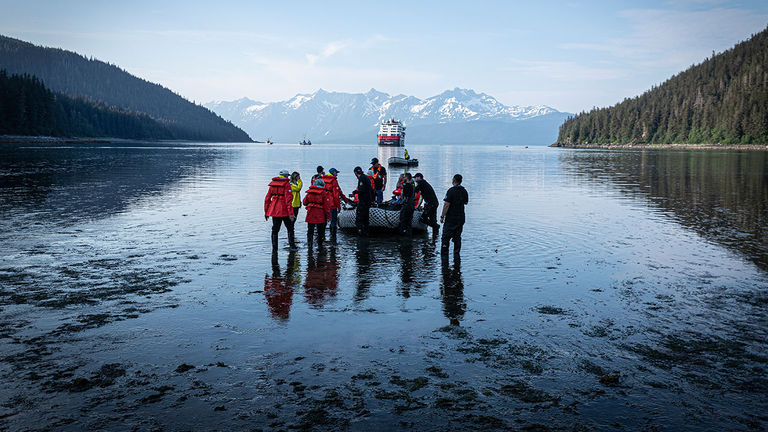 HX is known for its hybrid expedition ships.
HX is known for its hybrid expedition ships.
Credit: 2023 HXBy now, most advisors and their clients are aware of at least some of the efforts that cruise lines have made to visit remote destinations in an environmentally friendly manner — single-use plastic elimination, exhaust scrubbers and LED lighting, for instance — but there’s more happening, and more to come.
Here, we look at the current strides and future sustainability innovations in the expedition cruise industry, from ship design and power sources to artificial intelligence (AI) and culinary efficiency.
Moving Toward Better Energy Sources and Fewer Emissions
In an effort to embark on a path toward greater sustainability, more cruise lines and ships are moving away from oil-based fuels and employing transitional fuel, mainly liquefied natural gas (LNG), according to the 2023 State of the Cruise Industry report from Cruise Lines International Association (CLIA).
The report also found that 60% of ships coming online between 2023 and 2028 will utilize LNG as their primary source of propulsion, and that every CLIA-member ship under construction now through 2028 is scheduled to be fitted with shoreside power capabilities.
Unfortunately, expedition ships are an exception to that latter statistic, according to CLIA — but that, too, is changing. Since 2021, all but one ship in Hurtigruten Group’s HX (formerly known as Hurtigruten Expeditions) and Hurtigruten fleets tout zero-emission shore power connectivity. HX was even the first cruise company to connect to shore power in Iceland this September.
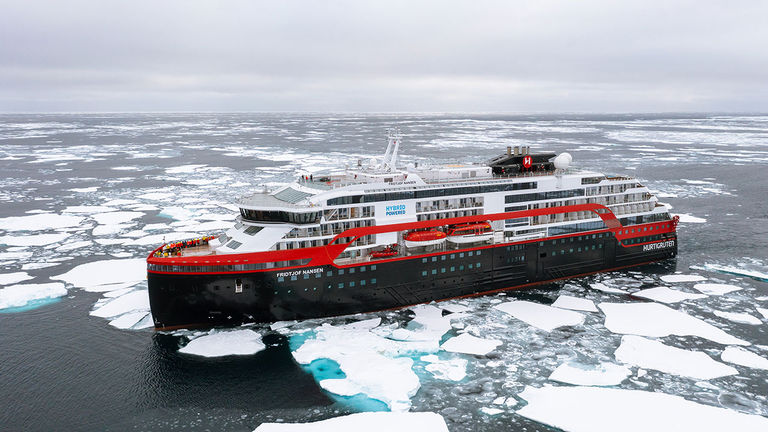 HX’s new Fridtjof Nansen vessel
HX’s new Fridtjof Nansen vessel
Credit: 2023 HXWhat’s more, HX and Scandinavian brand Havila Voyages, as well as the Le Commandant Charcot Polar Class 2 icebreaker from Ponant, are known for their hybrid approaches. The ships from these companies can run exclusively on clean electricity for several hours before switching to other fuel sources, resulting in no emissions.
In addition, Havila and Viking are both exploring the possibility of using hydrogen as a power source in the future.
Pioneering Methods to Reduce Impacts on Delicate Environments
Energy-efficient hull designs are a subtle but paramount way to increase sustainability in the expedition cruise industry. For example, an energy-efficient design on Viking’s two expedition ships — including a vertical-integrated bow that creates a longer waterline — contributes to the vessels exceeding Energy Efficiency Design Index requirements by almost 38%.
Expedition ships sporting the X-Bow — an architecturally striking and inverted bow concept from shipbuilder Ulstein — reduce their overall environmental impact, improve stability and experience better efficiency (and passenger comfort) in rough seas.
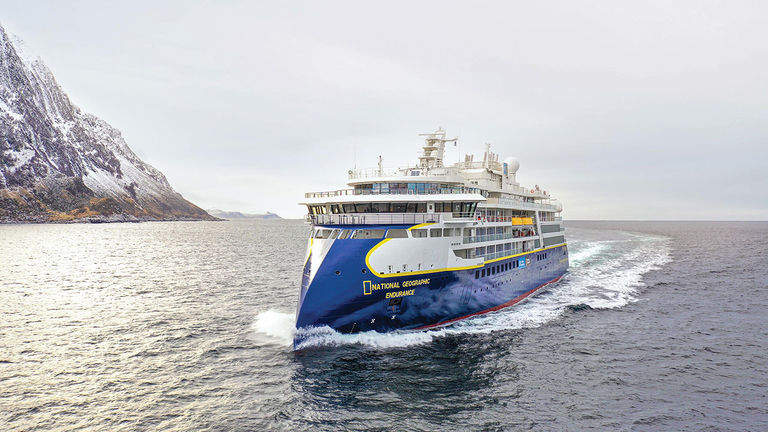 Vessels with the Ulstein X-Bow use less fuel.
Vessels with the Ulstein X-Bow use less fuel.
Credit: 2023 Lindblad Expeditions-National Geographic
As a result of the design, which reduces the slamming impact of wave energy, these vessels lower their fuel consumption and produce less emissions. Brands using the X-Bow in their fleets include American Queen Voyages, Albatros Expeditions, Lindblad Expeditions-National Geographic and Aurora Expeditions.
Just as key to reducing environmental impact is how ships physically interact with the locations they visit. For instance, to avoid dropping anchor onto fragile seabeds, many ships now situate themselves by dynamically positioning via satellite and lateral thrusters. Celebrity Flora, Celebrity Cruises’ Galapagos Islands ship, is utilizing this technology, as are all ships equipped with an X-Bow.
Senderoff of Cruise Planners says that Scenic Luxury Cruises & Tours’ Scenic Eclipse and Scenic Eclipse II are also able to position without reef-impacting anchors. Ships from Atlas Ocean Voyages, Silversea Cruises, Swan Hellenic and several others use a contactless system, as well.
Reducing Waste and Aiming for Culinary Sustainability
Although culinary sustainability isn’t often thought of as innovation, this hallmark of cruise travel — food — plays a crucial part in reducing cruising’s environmental impact.
Lindblad, for one, strives for the utmost level of sustainable seafood. It has not served shrimp on its ships for the last 20 years, as the line has found no responsible harvesting practices.
And at Scenic, Tom Goetter, who made waves as a contestant on the latest season of “Top Chef: World All-Stars,” was recently promoted from director of food and beverage to the line’s vice president of ocean hotel operations. He is doing some clever things in the name of efficiency onboard Eclipse and Eclipse II.
“We try modern toys and techniques in the kitchen to help reduce waste as our first priority,” Goetter said. “For example, we use flavor blasters at bars to create smell effects in cocktails and use modern smoker inserts, which allow us to make vegetable ash in modern rational ovens from old and leftover vegetables.”
Naturally, most brands are striving to reduce waste — food or otherwise. Seabourn is using biodigester systems and dehydrators in its goal to lessen food waste per person by 50% by 2030, while UnCruise Adventures is minimizing packaging waste in advance at the point of purchase.
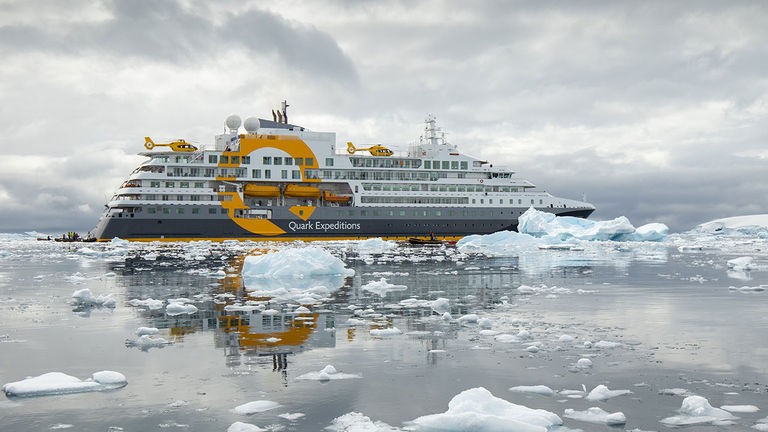 Ultramarine from Quark Expeditions features a special waste system.
Ultramarine from Quark Expeditions features a special waste system.
Credit: 2023 Quark ExpeditionsQuark Expeditions’ Ultramarine features a Micro Auto Gasification System (MAGS) that thermally breaks down waste and reduces waste volume by up to 95%. MAGS reduces carbon emissions and generates two byproducts that can be harnessed for efficiency: heat and biochar. Quasar Expeditions, meanwhile, is teaming up with World Wildlife Fund and its zero-waste initiative.
Bringing Guests Into the Mix
Beyond a focus on energy sources, hull design, physical impacts and waste reduction, another common sustainability objective in the industry is to teach travelers about conservation.
With the National Geographic Society, Lindblad developed conservation and education programs, and the National Geographic Explorers Program offers lessons for families visiting Alaska, Antarctica, Baja California and the Galapagos.
Several expedition lines also foster onboard citizen science and professional research. Guests on Lindblad, for example, have supported marine biologist Jimmy White in his endeavor to tag and track whales and protect shark and ray populations in the Great Barrier Reef.
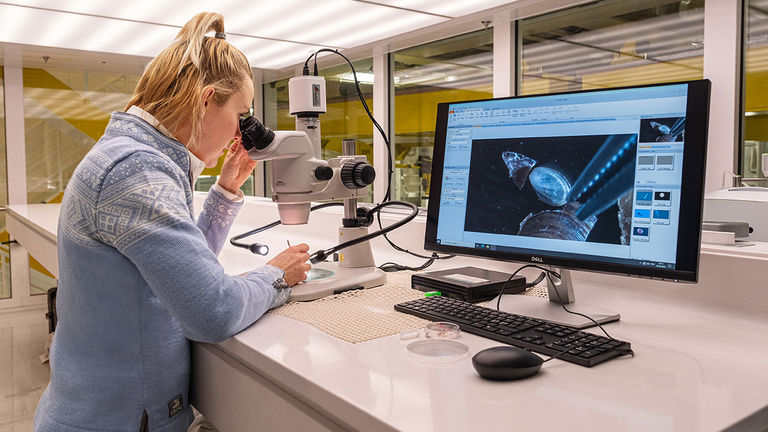 Citizen science onboard a Viking vessel gets clients involved.
Citizen science onboard a Viking vessel gets clients involved.
Credit: 2023 VikingMeanwhile, Viking passengers have engaged in lab workshops to count microplastics found in collected water samples; prepared “fish popsicle” bait for underwater camera deployments; and examined phytoplankton levels. When I was onboard Viking Octantis in the Caribbean, we observed as the ship deployed a weather balloon from the top deck to gather significant regional data.
The Little Things Matter
Of course, not all innovations need to be grand to resonate. Senderoff of Cruise Planners believes “the little things” are also an important factor in sustainability — such as reusable water containers and shifting from printed paper programs to digital apps.
I understand why these small, but impactful, shifts matter so much. Those everyday choices collectively make a big difference.
“These changes are tangible and relatable,” he said. “I understand why these small, but impactful, shifts matter so much. Those everyday choices collectively make a big difference.”
He notes a sign he saw recently on an Arctic expedition: “Eat all you want and keep coming for more, but don’t put more on your plate than you can eat — we waste enough food to feed 100 needy children daily.” Senderoff loved this simple way of making travelers aware of their potential impact.
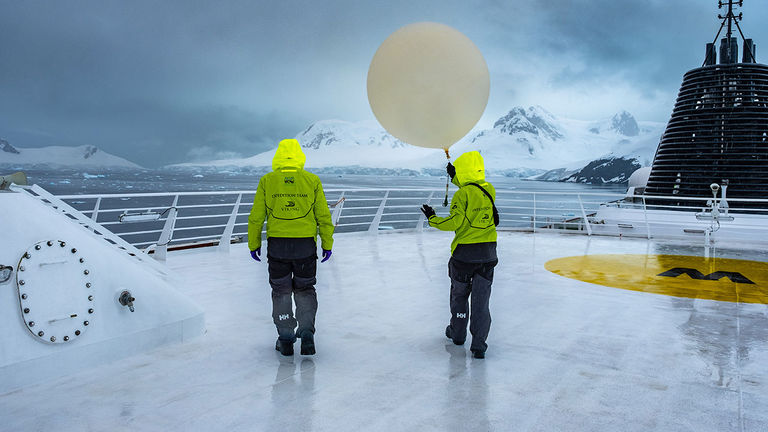 Viking launches weather balloons from its expedition ships.
Viking launches weather balloons from its expedition ships.
Credit: 2023 VikingHe says that although some of his clients think there is still room for improvement and will not book a cruise right now, he finds that most lines are proactive, and he believes future features — such as solar sails on ships — may influence client behavior.
“Technology is ready, and it will open doors for eco-conscious explorers,” he said.
Looking to the Future
And that future looks bright, as lines seek to revolutionize the industry with technology such as AI navigation, strides in efficient ship design and reliance on alternate energy sources.
Ponant, for example — which was recognized in 2020 as the most environmentally friendly cruise line by the Nature and Biodiversity Union — is working to introduce a zero-emission ship design by 2030. (Hurtigruten has the same goal and timeline.) Its vision is an angular, 594-foot-long sailing ship with 100 cabins.
Ponant’s research and development team is exploring technologies such as a sail-power system, which — combined with a streamlined hull — could provide half the ship’s propulsion. The system would also employ 1,000 square meters of photovoltaic panels on the sails and overall structure to capture solar power.
The line is also looking into using a low-temperature fuel cell that operates on liquid hydrogen for further propulsion; a high-temperature fuel cell for hotel operations that would recover the emitted heat for hot water production; an onboard carbon-capture system; and a custom energy management and distribution system that would eliminate generator use.
As for Hurtigruten, its approach for a zero-emission ship is a curvier but similarly sized vessel, at 443 feet long, featuring 270 cabins and three retractable sails. Its goal for these future electric ships is to use batteries that can be charged in port with renewable energy, along with solar and wind technology.
It will employ navigation that’s aided by AI and propelled by retractable thrusters; air lubrication, an advanced hull coating and proactive hull cleansing are also anticipated. The vessel’s streamlined form is expected to reduce air resistance and energy use while adding outdoor space and expanded views for passengers.
Guest participation will also help drive efficiency on this future ship. For example, by interacting with a mobile app, clients will be able to control stateroom ventilation and monitor personal water and energy consumption. In all, Hurtigruten’s objective with its concept ship is a 50% reduction in energy compared to its current fleet.
“We’re waking up to the profound fragility of our planet,” Senderoff said. “Earth’s the only place we’ve got, and it’s high time we protect it.”